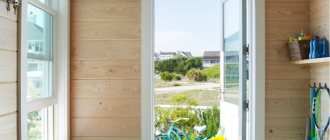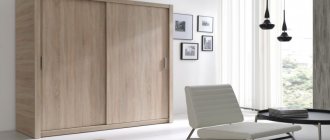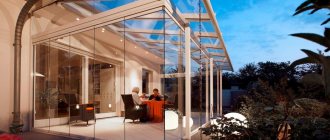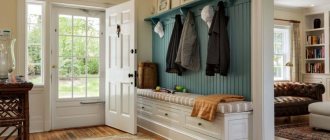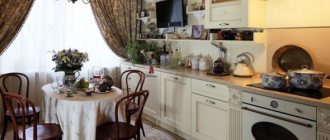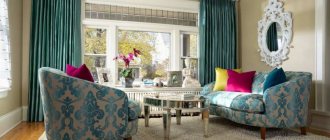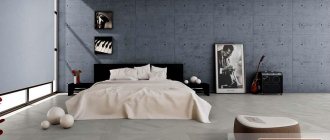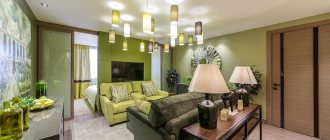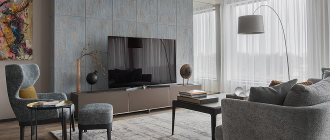The color of the walls creates the atmosphere in the house and the right choice determines what emotions household members experience while in a particular room. The same applies to the interior of the loggia, which at the moment is most often used as a full-fledged living room or recreation area. The choice of colors for this room has a number of subtleties and features. To choose the right color, you need to take into account not only the size of the loggia, but also its openness to sunlight, the style of the interior and the shape of the room. It is these subtleties of choosing colors that we will try to understand in our article.
What should you pay attention to first?
First of all, you need to remember your physics lessons, where it was said that a dark surface attracts and absorbs light waves, and the lighter the surface, the more waves it reflects. Based on the above, it follows that light walls will reflect light, and a dark floor will absorb waves, which will make its surface warmer. It is also necessary to pay attention to the location of the loggia relative to the light; if the windows are on the north side, then light pastel colors are used, if on the south - rich and intense shades.
At the same time, each color can have its own disadvantages, since sunlight not only heats the surface, but also affects the paint, as a result of which rich and bright colors begin to fade (especially noticeable on a black surface). But the white color gradually begins to turn yellow in the sun, which also does not look aesthetically pleasing. The color gray and its shades are least susceptible to the negative effects of the sun.
The influence of color on the human psyche
Scientists around the world claim that the colors surrounding a person can affect a person’s mental state. For example, shades of blue make a person calm and concentrated, red calls for action, but can irritate and cause aggression, but yellow stabilizes the functioning of the nervous system and gives a person strength.
A room decorated in orange promotes relaxation and restoration, helps to engage in creativity, but in excess it leads to absent-mindedness. Shades of green improve vision and stimulate mental activity. Purple color – tunes to creativity and removes feelings of anxiety, and white creates a feeling of spaciousness and lightness, but with its excess, the feeling of comfort disappears.
A color scheme
When decorating the interior of a loggia, it is important to correctly combine several colors that can change the visual perception of the room. In order to make the loggia more spacious, it is enough to paint its walls in pastel shades. You can also use color to change the shape of a room, for example, you can make it less narrow by painting a smaller wall in a shade that is darker than the others used to decorate the room.
With the help of paints, you can not only visually change the shape of a room or its size, but also hide defects. In order to achieve a certain visual effect, a combination of colors is used, consider some of them:
- White is a universal background color that goes harmoniously with all shades of the palette.
- Orange color - best combined with green flooring, the degree of saturation of which is the same as that of the walls.
- Pink or beige are the colors most often used for zoning space.
- Spicy color - suitable for creating an interior in an exotic style. To do this, use the tones of cardamom, turmeric and cinnamon, harmoniously combined with a beige or yellow base.
- Earthy, natural shades will create a cozy atmosphere and bring household members closer to nature. Optimal combination: sand or brown surface with wood paneling.
- Blue is a cool color that calms and relaxes. Using this shade, you can create a relaxation area by combining blue with rich blue or gray flooring.
Features of choice depending on the base
Different types of substrates can only be painted with specially selected materials. In order for the paint to lie evenly on the surface and not lose its appearance and performance characteristics in a short time, you need to take into account compatibility with the base.
Brickwork
In many residential buildings, the walls on the balconies are made of brick. Before painting, the base is coated with acrylic emulsion, after which two layers of water-based emulsion are applied. If desired, the composition is diluted with dye to obtain a specific shade.
Concrete
The best options for concrete bases are plastic and silicate paints. They can be applied to the internal and external surfaces of walls. Strong adhesion to the base ensures durability and resistance to external influences.
See also
Which table is best to choose to create a harmonious interior in the kitchen, tips
Plastered surfaces
It is best to treat plastered surfaces with acrylate compounds, which are highly resistant to moisture and ultraviolet exposure. Using colored pigments, you can give the surface the desired shade.
Wood or plywood
You can paint plywood or wood sheathing with ordinary acrylic material, which is easy to apply and has good decorative properties. It is also possible to finish using simple oil paint.
Drywall
Water-based compositions diluted with color are well suited for drywall. It is recommended to use matte shades that visually hide the imperfections of the base.
Plastic
The easiest way to paint plastic is with a water-based acrylic material. If you choose the wrong coating, it will bleed on the plastic base.
Surface texture matters
When choosing a color, it is important to focus not only on the design style of the loggia and personal taste preferences, but also on the texture of the surface. Depending on the method of finishing the floor, ceiling and walls, the perception of the same color will change. In order to choose the right color, it is important to know how its perception changes depending on a particular surface texture:
- Matte – warmer.
- Glatkaya - lighter.
- Polished - cooler.
- Rough - darker.
Photos of wall finishing options on the balcony
Read here! Box on the balcony - why is it needed? How to make it yourself? Instructions + photos + video!
How to adjust space using color?
Using design techniques, you can not only visually enlarge a room or hide its shortcomings, but also adjust the shape of the room. The use of contrasts and the use of intense dark shades combined with light pastel colors is a classic solution that allows you to visually improve the shape of the loggia. Let's look at the most popular options and principles for their implementation.
The first option is dark walls and floors with a light ceiling. This combination is considered a classic universal interior option, where there is a gradual transition from light to dark colors. By correctly combining shades, you can balance the load between planes, creating a cozy room. The color of furniture and decorative elements depends on the overall tone of the loggia.
The second solution is a dark floor, bright walls and a light ceiling. This solution is used if the ceilings are low and need to be visually “raised.” Vertical stripes will also help to cope with this. The third option is dark floors and ceilings, light walls. If the ceilings in the loggia are too high, then you can bring them closer using cool tones and dark shades.
Another solution is a dark floor, light walls and ceiling. This color combination is used on small loggias with low ceilings. The dark coating serves as an excellent base, attracting heat and creating depth, but light shades will visually “lighten” the remaining surfaces. You can complement the space with a small light rug, compact furniture and transparent tulle on the windows.
Modern style
A small loggia in a modern style is a good solution. The minimalism inherent in the style visually enlarges the room.
One color is taken as a basis, with the addition of one or two others. The main color can be white, gray, beige and black. Additional colors: turquoise, terracotta, blue, yellow.
Suitable finishing materials include plasterboard, suspended ceilings, parquet, laminate, paint and plaster.
Choose multifunctional furniture, mostly without handles.
Original vases and flower pots, posters and photographic paintings can serve as decoration.
A cozy work corner or a small relaxation area will look good in this style.
Taking inspiration from photo ideas of loggia styles, you are sure to find one that suits your taste.

